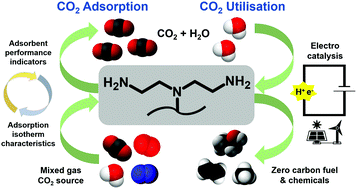The application of amine-based materials for carbon capture and utilisation: an overarching view†
Abstract
In the ongoing research campaign to reduce the global atmospheric CO2 concentration, technologies are being developed to enable the capture of CO2 from dilute sources and conversion into higher-value products. Amine and polyamine-based materials feature widely in the literature as solid CO2 sorbents and as catalyst modifiers for CO2 electrochemical reduction; however, advancing lab-scale research into a pilot or industrial-scale application is fraught with challenges, starting with the definition and identification of an effective adsorbent. This multidisciplinary review serves as an essential introduction to the role of amines in carbon capture and utilisation for scientists entering and advancing the field. The chemical and engineering principles of amine-based CO2 capture are considered to define the parameters required of an adsorbent, describe adsorption testing methods, and introduce the reader to a range of amine-based adsorbents and how they can be specialised to overcome specific issues. Finally, the application of electrocatalysts modified with nitrogen-containing compounds and polymers is reviewed in the context of CO2 utilisation.

- This article is part of the themed collections: Hybrid Pores for CO2 Technologies and Popular Advances


 Please wait while we load your content...
Please wait while we load your content...